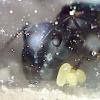My P. rogosus colony from Drew was small to begin with and had a few die offs which got me worried. I now have them in a Talus and they appear comfortable, just a queen with three workers. I haven't been able to find any brood to boost it with. I've been giving them water, Blue and Aqua, and keeping the temp around high 80's.
Is there anything else I can do to make sure they're comfortable and hopefully start producing more brood?


















